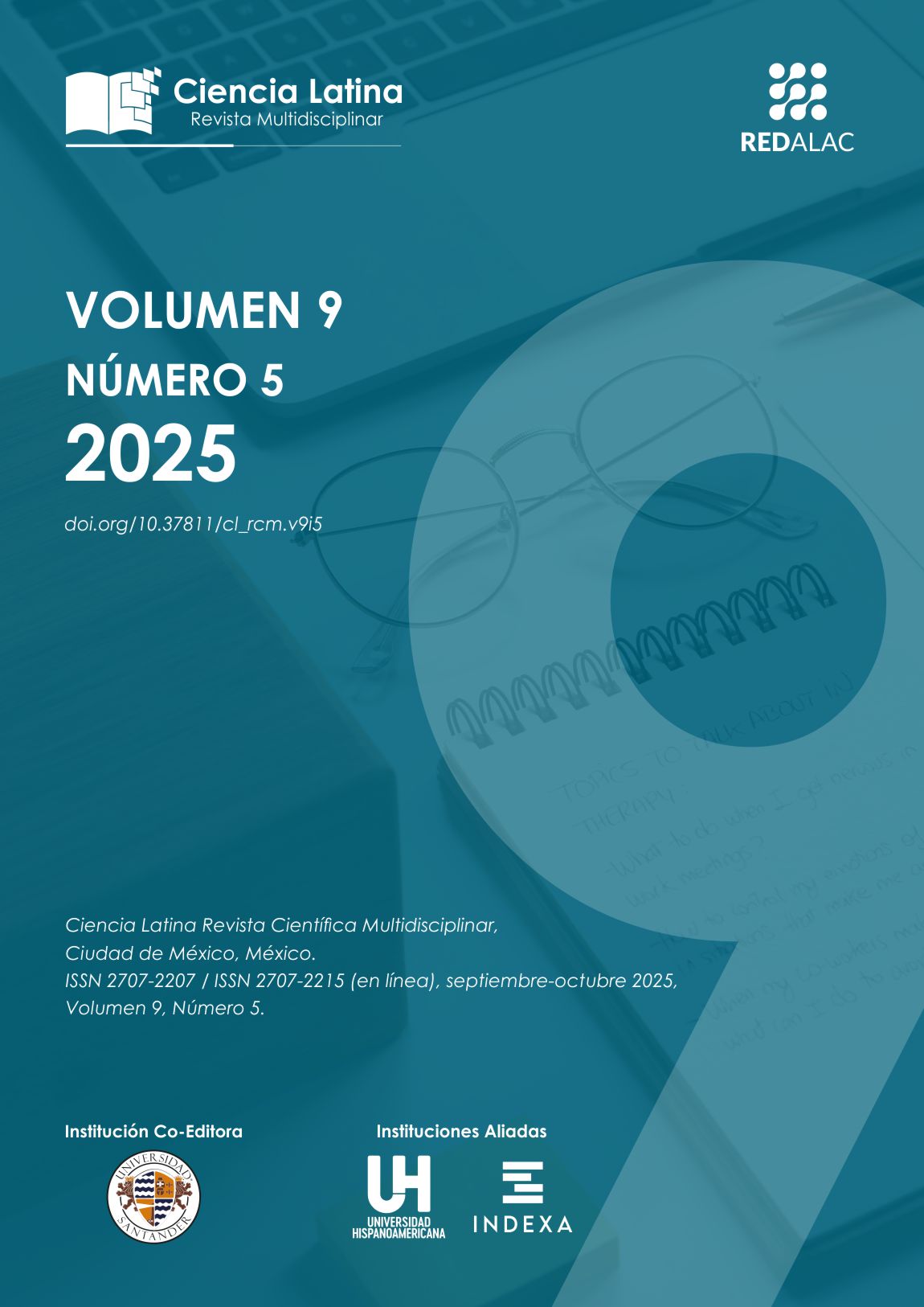Análisis Lingüístico Asistido por Inteligencia Artificial: Estudio Piloto de Caracterización Lingüística y Psicopatológica en Pacientes Psiquiátricos en Seguimiento Clínico
Resumen
Se presenta un estudio piloto orientado a evaluar la utilidad y precisión diagnóstica de la inteligencia artificial (IA) en psiquiatría mediante el análisis lingüístico asistido por la grabadora de aplicaciones inteligentes AIREC. Se incluyeron 10 pacientes en seguimiento clínico en Guaymas, Sonora, México, con diagnósticos categoriales DSM-5-TR. Los registros de audio fueron transcritos por el dispositivo y procesados con algoritmos de IA (ChatGPT-5, Google Speech-to-Text, DeepSearch). La concordancia diagnóstica con el clínico humano fue del 78%. Las discrepancias se concentraron en la interpretación de prosodia emocional, neologismos y fragmentación narrativa. Este trabajo surge ante la creciente necesidad de herramientas tecnológicas que optimicen los procesos de evaluación psiquiátrica en contextos donde existe escasez de personal especializado. El estudio describe cómo la integración de sistemas de IA permite identificar patrones idiolécticos y lingüísticos asociados a distintos cuadros psicopatológicos, aportando información complementaria al juicio clínico tradicional. Los resultados obtenidos resaltan la importancia de adaptar los algoritmos a factores culturales y contextuales específicos, así como de perfeccionar la detección de matices emocionales en el lenguaje. Los hallazgos sugieren que la IA puede constituir un recurso de apoyo diagnóstico complementario, con potencial de mejorar la precisión y eficiencia en la atención psiquiátrica, especialmente en regiones con recursos limitados y alta demanda de servicios de salud mental.
Descargas
Citas
Aggarwal, R., Sounderajah, V., Martin, G., Ting, D. S. W., Karthikesalingam, A., King, D., Ashrafian, H., & Darzi, A. (2021). Diagnostic accuracy of deep learning in medical imaging: A systematic review and meta-analysis. NPJ Digital Medicine, 4(1), 65. https://doi.org/10.1038/s41746-021-00438-z
Bird, A. D., Jedlicka, P., & Cuntz, H. (2021). Dendritic normalisation improves learning in sparsely connected artificial neural networks. PLoS computational biology, 17(8), e1009202. https://doi.org/10.1371/journal.pcbi.1009202
Buitimea Valenzuela, C., Estrada Fernández, Z., Grageda Bustamante, A., & Silva Encinas, M. C. (2016). Diccionario yaqui de bolsillo: Jiak noki español, español Jiak noki. Universidad de Sonora. https://letrasylinguistica.unison.mx/wp-content/uploads/2018/09/2016Diccionario_Yaqui_Espanol.pdf
Cámara de Diputados del H. Congreso de la Unión. (2025). Ley Federal de Protección de Datos Personales en Posesión de los Particulares (Nueva Ley publicada en el Diario Oficial de la Federación el 20 de marzo de 2025). https://www.diputados.gob.mx/LeyesBiblio/pdf/LFPDPPP.pdf
Carnegie Mellon University Libraries. (2020, 6 de julio). The imitation game: Rare Alan Turing article at CMU Libraries. https://www.library.cmu.edu/about/news/2020-07/imitation-game-rare-alan-turing-article-cmu-libraries
Chavlis, S., & Poirazi, P. (2025). Dendrites endow artificial neural networks with accurate, robust and parameter-efficient learning. Nature Communications, 16(1), 1193. https://doi.org/10.1038/s41467-025-56297-9
Chekroud, A. M., Bondar, J., Delgadillo, J., Doherty, G., Wasil, A., Fokkema, M., Cohen, Z., Belgrave, D., DeRubeis, R., Iniesta, R., Dwyer, D., & Choi, K. (2021). The promise of machine learning in predicting treatment outcomes in psychiatry. World Psychiatry, 20(2), 154–170. https://doi.org/10.1002/wps.20882
Colby, K. M. (1972). PARRY: A computer simulation of paranoid behavior. Stanford University.
Comisión Nacional de Bioética; Consejo Nacional de Ciencia y Tecnología (CONACYT). (2015). Ética de la investigación: integridad científica [Libro]. https://www.conbioetica-mexico.salud.gob.mx/descargas/pdf/Libro_Etica_de_la_Investigacion_gratuito.pdf
Congreso de los Estados Unidos Mexicanos. (1994). Ley General de Salud (última reforma 07-06-2024). https://www.diputados.gob.mx/LeyesBiblio/pdf/LGS.pdf
Congreso de los Estados Unidos Mexicanos. (2014). Reglamento de la Ley General de Salud en materia de investigación para la salud (Reg_LGS_MIS). https://www.diputados.gob.mx/LeyesBiblio/regley/Reg_LGS_MIS.pdf
Crespo Cobo, Y., Esteban, F. J., Iglesias Parro, S., Paredes Olay, C., & Molina López, R. (2025). La escritura como biomarcador del estado de salud mental. Seminario Médico, 65(1), 11–22.
Croskerry, P., Singhal, G., & Mamede, S. (2013). Cognitive debiasing 1: Origins of bias and theory of debiasing. BMJ Quality & Safety, 22(Suppl 2), ii58–ii64. https://doi.org/10.1136/bmjqs-2012-001712
Curtiss, J., & DiPietro, B. C. (2025). Machine learning in the prediction of treatment response for emotional disorders: A systematic review and meta-analysis. Clinical Psychology Review, 120, 102593. https://doi.org/10.1016/j.cpr.2025.102593
Dell’Armo, K., & Tassé, M. J. (2023). Diagnostic overshadowing of psychological disorders in people with intellectual disability: A systematic review. American Journal on Intellectual and Developmental Disabilities. Advance online publication. https://www.aaidd.org/docs/default-source/prepressarticles/diagnostic-overshadowing-of-psychological-disorders-in-people-with-intellectual-disability-systematic-review.pdf?sfvrsn=1fd20221_0
Dikaios, K., Rempel, S., Dumpala, S. H., Oore, S., Kiefte, M., & Uher, R. (2023). Applications of speech analysis in psychiatry. Harvard Review of Psychiatry, 31(1), 1–13. https://doi.org/10.1097/HRP.0000000000000356
Doherty, T. S., & Balzer, W. K. (2020). Cognitive and affective processes in clinical decision-making: Implications for ethical practice. AMA Journal of Ethics, 22(9), E742–E748. https://doi.org/10.1001/amajethics.2020.742
Dziadkowiec, O., Callahan, K. E., O’Connor, S., & Williams, J. S. (2020). Artificial intelligence in health care: Benefits and challenges of implementation. HCA Healthcare Journal of Medicine, 1(0), 1–9. https://doi.org/10.36518/2689-0216.1010
Ehlen, F., Montag, C., Leopold, K., & Heinz, A. (2023). Linguistic findings in persons with schizophrenia: A review of the current literature. Frontiers in Psychology, 14, 1287706. https://doi.org/10.3389/fpsyg.2023.1287706
Emanuel EJ, Wendler D, Grady C. What makes clinical research ethical? JAMA. 2000 May 24-31;283(20):2701-11. doi: 10.1001/jama.283.20.2701. PMID: 10819955.
European Parliament, & Council of the European Union. (2024). Regulation (EU) 2024/1689 of the European Parliament and of the Council of 13 June 2024 laying down harmonised rules on artificial intelligence and amending certain Union legislative acts (Artificial Intelligence Act). Official Journal of the European Union, L, 12.7.2024, 1–144. http://data.europa.eu/eli/reg/2024/1689/oj
Fernandino, L., Binder, J. R., Desai, R. H., Humphries, C. J., Gross, W. L., Conant, L. L., & Seidenberg, M. S. (2022). Decoding the information structure underlying the neural representational code of lexical semantics in heteromodal cortex. Proceedings of the National Academy of Sciences, 119(52), e2207398120. https://doi.org/10.1073/pnas.2207398120
Franco Trujillo, E. D. (2020). Reflexiones en torno a la variación léxica en el ámbito hispánico y la traducción. Estudios de Lingüística Aplicada, 38(71), 145–176. https://doi.org/10.22201/enallt.01852647p.2020.71.905
Fulmer, R., Joerin, A., Gentile, B., Lakerink, L., & Rauws, M. (2018). Using psychological artificial intelligence (Tess) to relieve symptoms of depression and anxiety: Randomized controlled trial. JMIR Mental Health, 5(4), e64. https://doi.org/10.2196/mental.9782
Fusar-Poli, P., Davies, C., Karpenko, O., Christodoulou, N., Ramalho, R., Nandha, S., Damiani, S., Provenzani, U., Esposito, C. M., Mensi, M. M., Borgatti, R., Stefana, A., McGuire, P., & Minichino, A. (2019). Preventive treatments for psychosis: Umbrella review. Frontiers in Psychiatry, 10, 764. https://doi.org/10.3389/fpsyt.2019.00764
Future Care Capital. (2023). Analysis of speech patterns can diagnose mental illness. https://futurecarecapital.org.uk/latest/analysis-of-speech-patterns-can-diagnose-mental-illness/
Goodfellow, I., Bengio, Y., & Courville, A. (2016). Deep learning. MIT Press. https://www.deeplearningbook.org
Granados, A. (2017). “¡Oye, tú, bato!, ¿Dónde están los plebes y tu morra?” Aproximación lexicológica, mediante la dialectología perceptual, al habla de Bahía de Kino y Guaymas, Sonora. Káñina, Revista de Artes y Letras, Universidad de Costa Rica, 41(1), 59–68. https://revistas.ucr.ac.cr/index.php/kanina/article/view/29379
Greden, J. F., Parikh, S. V., Rothschild, A. J., et al. (2019). Effect of pharmacogenomic testing for drug-gene interactions on medication selection and remission of symptoms in major depressive disorder. JAMA Psychiatry, 76(1), 19–28. https://jamanetwork.com/journals/jama/fullarticle/2794053
Heim, E., Karatzias, T., & Maercker, A. (2022). Cultural concepts of distress and complex PTSD: Future directions. Clinical Psychology Review, 93, 102143. https://doi.org/10.1016/j.cpr.2022.102143
Hinton, G. E., Osindero, S., & Teh, Y. W. (2006). A fast learning algorithm for deep belief nets. Neural Computation, 18(7), 1527–1554. https://doi.org/10.1162/neco.2006.18.7.1527
Holmes, E. A., Ghafur, S., & Shafran, R. (2021). Artificial intelligence in mental health: The state of the art and future prospects. Nature Medicine, 27(5), 766–781. https://doi.org/10.1038/s41591-021-01362-5
IBM. (s. f.). Large language models. IBM. Recuperado el 24 de septiembre de 2025, de https://www.ibm.com/think/topics/large-language-models
Instituto Mexicano del Seguro Social. (2012). Norma Oficial Mexicana NOM-012-SSA3-2012, para la vigilancia epidemiológica, prevención, y control de las infecciones nosocomiales (versión publicada). https://www.imss.gob.mx/sites/all/statics/profesionalesSalud/investigacionSalud/normativaNac/4_NOM-012-SSA-3-2012.pdf
Instituto Nacional de los Pueblos Indígenas. (2020). Lengua yaqui [Atlas de los Pueblos Indígenas de México]. Gobierno de México. https://atlas.inpi.gob.mx/yaquis-lengua/
Jiang, J., Liu, R., & Demner-Fushman, D. (2023). Large language models for the mental health community: Framework for translating code to care. NPJ Digital Medicine, 6, 150. https://doi.org/10.1038/s41746-023-00849-2
Johnson, B. T., Low, T. L., & MacDonald, G. (2019). Advances in meta-analysis for health sciences: Research synthesis methods and applications. Research Synthesis Methods, 10(2), 126–145. https://doi.org/10.1002/jrsm.1337
Kaul, V. (2020). History of artificial intelligence in medicine. Gastrointestinal Endoscopy, 91(3), 523–532. https://doi.org/10.1016/j.gie.2019.10.028
Kaul, V. (2020). History of artificial intelligence in medicine. Gastrointestinal Endoscopy, 91(3), 523–532. https://doi.org/10.1016/j.gie.2019.10.028
Kayrouz, R., Karin, E., Staples, L., et al. (2024). A quantitative systematic review to evaluate the favorability of the DSM-5 CFI. Journal of Cross-Cultural Psychology, 55(8), 835–864. https://doi.org/10.1177/00220221241269994
Krizhevsky, A., Sutskever, I., & Hinton, G. E. (2012). ImageNet classification with deep convolutional neural networks. Advances in Neural Information Processing Systems, 25, 1097–1105. https://doi.org/10.1145/3065386
LeCun, Y., Bengio, Y., & Hinton, G. (2015). Deep learning. Nature, 521(7553), 436–444. https://doi.org/10.1038/nature14539
Lefkowitz, M. (2019, 25 de septiembre). Professor’s perceptron paved the way for AI – 60 years too soon. Cornell Chronicle. https://news.cornell.edu/stories/2019/09/professors-perceptron-paved-way-ai-60-years-too-soon
Li, H., Wong, C. K. H., & Cheung, C. L. (2023). Systematic review and meta-analysis of AI-based conversational agents for promoting mental health and well-being. NPJ Digital Medicine, 6, 180. https://doi.org/10.1038/s41746-023-00849-2
Li, R., Wang, X., Lawler, K., Garg, S., Bai, Q., & Alty, J. (2022). Applications of AI to aid early detection of dementia. Journal of Biomedical Informatics, 127, 104030. https://arxiv.org/abs/2104.14073
Lin, Y., Ding, H., & Zhang, Y. (2018). Emotional prosody processing in schizophrenia: A meta-analysis. Journal of Clinical Medicine, 7(10), 363. https://doi.org/10.3390/jcm7100363
Liu, X., Faes, L., Kale, A. U., et al. (2019). A comparison of deep learning performance against health-care professionals in detecting diseases from medical imaging: A systematic review and meta-analysis. The Lancet Digital Health, 1(6), e271–e297. https://doi.org/10.1016/S2589-7500(19)30123-2
Lope Blanch, J. M., Alcalá Alba, A., Ávila, R., et al. (1990). Atlas lingüístico de México. Tomo I: Fonética (Vol. 1). El Colegio de México.
Low, D. M., Bentley, K. H., & Ghosh, S. S. (2020). Automated assessment of psychiatric disorders using speech: A systematic review. Laryngoscope Investigative Otolaryngology, 5(1), 96–116. https://doi.org/10.1002/lio2.354
Mahowald, K., James, A., Futrell, R., & Gibson, E. (2016). A meta-analysis of syntactic priming in language production. Journal of Memory and Language, 91, 5–27. https://doi.org/10.1016/j.jml.2016.03.009
Manuales+. (s. f.). Manual de usuario de la grabadora de aplicaciones inteligentes AIREC [Manual]. https://manuals.plus/es/airec/smart-app-recorder-manual
Mbuagbaw, L., Lawson, D. O., Puljak, L., Allison, D. B., & Thabane, L. (2020). A tutorial on methodological studies: The what, when, how and why. BMC Medical Research Methodology, 20, 226. https://doi.org/10.1186/s12874-020-01140-4
McCoy, T. H., & Perlis, R. H. (2024). Characterizing RDoC symptoms among psychiatric inpatients using LLMs. Journal of Mood & Anxiety Disorders, 8, 100079. https://pubmed.ncbi.nlm.nih.gov/40655912/
Méndez Ramírez, I., Namihira Guerrero, D., Moreno Altamirano, L., & Sosa de Martínez, C. (1990). El protocolo de investigación: Lineamientos para su elaboración y análisis (2. ª ed., reimpresa 1996). México: Trillas.
Mirheidari, B., Blackburn, D., Walker, T., Reuber, M., & Christensen, H. (2019). Dementia detection using automatic analysis of conversations. Computer Speech & Language, 53, 65–79. https://eprints.whiterose.ac.uk/id/eprint/136339/8/CSL_2018_Revised.pdf
Nagendran, M., Chen, Y., Lovejoy, C., Gordon, A. C., Komorowski, M., Harvey, H., Topol, E. J., … & Maruthappu, M. (2020). Artificial intelligence versus clinicians: Systematic review of design, reporting standards, and claims of deep learning studies in medical imaging. The BMJ, 368, m689. https://doi.org/10.1136/bmj.m689
Newson, J. J., Pastukh, V., & Thiagarajan, T. C. (2021). Poor separation of clinical symptom profiles by DSM-5 disorder criteria. Frontiers in Psychiatry, 12, 775762. https://doi.org/10.3389/fpsyt.2021.775762
Noriega Jacob, M. A. (Comp.). (2016). Estudios del lenguaje en el noroeste de México. Centro Regional de Formación Docente e Investigación Educativa del Estado de Sonora. https://creson.sonora.edu.mx/images/INVESTIGACION/LIBROS/estudios_del_lenguaje_en_el_noroeste_de_mexico_a125387f5b_compressed.pdf
Núñez-Méndez, E. (2022). Variation in Spanish /s/: Overview and new perspectives. Languages, 7(2), 77. https://doi.org/10.3390/languages7020077
O’Sullivan, E. D., & Schofield, S. J. (2018). Cognitive bias in clinical medicine. Journal of the Royal College of Physicians of Edinburgh, 48(3), 225–232. https://doi.org/10.4997/JRCPE.2018.306
Organisation for Economic Co-operation and Development. (2019). OECD principles on artificial intelligence. OECD. https://oecd.ai/en/ai-principles
Organización Mundial de la Salud. (2021). La OMS publica el primer informe mundial sobre inteligencia artificial (IA) aplicada a la salud y seis principios rectores relativos a su concepción y utilización. https://www.who.int/es/news/item/28-06-2021-who-issues-first-global-report-on-ai-in-health-and-six-guiding-principles-for-its-design-and-use
Oxford University. (2024, January 3). The way the brain learns is different from AI systems: prospective configuration mechanism. https://www.ox.ac.uk/news/2024-01-03-study-shows-way-brain-learns-different-way-artificial-intelligence-systems-learn
Paass, G. (2021, 21 de abril). Deep learning: How do deep neural networks work? Lamarr Institute. https://lamarr-institute.org/blog/deep-neural-networks/
Pan, Y., Zhang, T., Wu, L., et al. (2023). Diagnostic accuracy of deep learning using speech samples in depression: A systematic review and meta-analysis. Psychological Medicine, 53(10), 4562–4576. https://doi.org/10.1017/S0033291723001854
Parola, A., et al. (2023). Voice patterns as markers of schizophrenia: A systematic review. Schizophrenia Bulletin, 49(Suppl.), s. p.
Parola, A., Simonsen, A., Bliksted, V., & Fusaroli, R. (2022). Language abnormalities in schizophrenia: Binding core symptoms through contemporary empirical evidence. Schizophrenia Bulletin, 48(1), 180–192. https://doi.org/10.1093/schbul/sbac152
Pearson, A. L., Tribby, C., Brown, C. D., Yang, J.-A., Pfeiffer, K., & Jankowska, M. M. (2024). Systematic review of best practices for GPS data usage, processing, and linkage in health, exposure science and environmental context research. BMJ Open, 14, e077036. https://doi.org/10.1136/bmjopen-2023-077036
Pople, H. E., Jr., Miller, R. A., & Myers, J. D. (1982). Internist-1: An experimental computer-based diagnostic consultant for general internal medicine. New England Journal of Medicine, 307(8), 468–476. https://doi.org/10.1056/NEJM198208193070804
Quaak, M., van de Mortel, L., Thomas, R. M., & van Wingen, G. (2021). Deep learning applications for the classification of psychiatric disorders using neuroimaging data: Systematic review and meta-analysis. NeuroImage: Clinical, 30, 102584. https://doi.org/10.1016/j.nicl.2021.102584
Regier, D. A., Narrow, W. E., Clarke, D. E., Kraemer, H. C., Kuramoto, S. J., Kuhl, E. A., & Kupfer, D. J. (2013). DSM-5 field trials in the United States and Canada, Part II: Test-retest reliability of selected categorical diagnoses. American Journal of Psychiatry, 170(1), 59–70. https://doi.org/10.1176/appi.ajp.2012.12070999
Reid, M. C., Carpenter, J. S., & Naylor, M. D. (2019). Diagnostic error in mental health: A review. General Hospital Psychiatry, 60, 12–19. http://qualitysafety.bmj.com/
Robins, L. N., Helzer, J. E., Croughan, J. L., & Ratcliff, K. S. (1981). National Institute of Mental Health diagnostic interview schedule: Its history, characteristics, and validity. Archives of General Psychiatry, 38(4), 381–389. https://doi.org/10.1001/archpsyc.1981.01780290015001
Rony, M. K. K., Das, D. C., Khatun, T., et al. (2025). Artificial intelligence in psychiatry: A systematic review and meta-analysis of diagnostic and therapeutic efficacy. Digital Health, 11, 1–19. https://doi.org/10.1177/20552076251330528
Rumelhart, D. E., Hinton, G. E., & Williams, R. J. (1986). Learning representations by back-propagating errors. Nature, 323(6088), 533–536. https://doi.org/10.1038/323533a0
Ryan, K., Yang, H., Kim, B., & Kim, J. P. (2025). Assessing the impact of AI on physician decision-making for mental health treatment in primary care. npj Mental Health Research, 4, 16. https://doi.org/10.1038/s44184-025-00016-1
Salinas, M. P., Sepúlveda, J., Hidalgo, L., Peirano, D., Morel, M., Uribe, P., Rotemberg, V., Briones, J., Mery, D., & Navarrete-Dechent, C. (2024). A systematic review and meta-analysis of artificial intelligence versus clinicians for skin cancer diagnosis. NPJ Digital Medicine, 7(1), 125. https://doi.org/10.1038/s41746-024-01103-x
Saposnik, G., Redelmeier, D. A., Ruff, C. C., & Tobler, P. N. (2016). Cognitive biases associated with medical decisions: A systematic review. BMC Medical Informatics and Decision Making, 16, 138. https://doi.org/10.1186/s12911-016-0377-1
Sarangi, S., & Sharma, P. (2025). Inteligencia artificial: evolución, ética y políticas públicas (S. M. Olivares Bari, Trad.). Trillas. (Obra original publicada en 2018). ISBN 978-607-17-4862-1
Secretaría de Economía. (2020). Guaymas: Perfil sociodemográfico y económico. DataMéxico. https://www.economia.gob.mx/datamexico/es/profile/geo/guaymas
Shen, H., Zhang, L., Xu, C., Zhu, J., Chen, M., & Fang, Y. (2018). Analysis of misdiagnosis of bipolar disorder in an outpatient setting. Shanghai Archives of Psychiatry, 30(2), 93–101. https://doi.org/10.11919/j.issn.1002-0829.217080
Shortliffe, E. H., Buchanan, B. G., & Cohen, S. N. (1976). MYCIN: An early expert system for bacterial infection diagnosis and antibiotic recommendations [Tesis doctoral, Universidad de Stanford]. Stanford University.
Spitzer, R. L., & colaboradores. (1970). Psychiatric Status Schedule. New York State Psychiatric Institute.
Templin, T., Boehme, P., & Rieckmann, N. (2025). Evaluation framework for bias in large language models for clinical decision support. NPJ Digital Medicine, 8, 123. https://pmc.ncbi.nlm.nih.gov/articles/PMC12234702/
Time. (2024, agosto 7). Microsoft’s AI is now better than doctors at diagnosing patients. Time Magazine. https://time.com/7299314/microsoft-ai-better-than-doctors-diagnosis/
Turing, A. M. (1950). Computing machinery and intelligence. Mind, 59(236), 433–460. https://doi.org/10.1093/mind/LIX.236.433
Wang, S. (2025, agosto 13). Capabilities of GPT 5 on multimodal medical reasoning (arXiv:2508.08224 v2) [Preprint]. arXiv. https://doi.org/10.48550/arXiv.2508.08224
Wang, Y., Chen, H., Patel, R., et al. (2024). Evaluating BERT-based and large language models for suicide detection, prevention, and risk assessment: A systematic review. Frontiers in Psychiatry, 15, 138902. https://doi.org/10.3389/fpsyt.2024.138902
Weizenbaum, J. (1966). ELIZA—a computer program for the study of natural language communication between man and machine. Communications of the ACM, 9(1), 36–45. https://doi.org/10.1145/365153.365168
World Health Organization. (2024). Ethics and governance of artificial intelligence for health: Guidance on large multimodal models. Geneva: WHO. https://www.who.int/publications/i/item/9789240084759
Wu, Z., Wang, J., Zhang, C., Peng, D., Mellor, D., Luo, Y., & Fang, Y. (2024). Clinical distinctions in symptomatology and psychiatric comorbidities between misdiagnosed bipolar I and bipolar II disorder versus major depressive disorder. BMC Psychiatry, 24, 352. https://doi.org/10.1186/s12888-024-05810-3
Zhang, Y., Ji, Y., & Papafragou, A. (2023). Representation of event boundedness in English and Mandarin speakers. Journal of Memory and Language, 132, 104373. https://doi.org/10.1016/j.jml.2022.104373
Zhu, J., & Jurgens, D. (2021). Idiosyncratic but not arbitrary: Learning idiolects in online registers reveals distinctive yet consistent individual styles. In M.-F. Moens, X. Huang, L. Specia, & S. W.-t. Yih (Eds.), Proceedings of the 2021 Conference on Empirical Methods in Natural Language Processing (pp. 279–297). Association for Computational Linguistics. https://doi.org/10.18653/v1/2021.emnlp-main.25
Sánchez Sánchez, J. E., & Fernández Paradas, A. R. (2025). Análisis de Estrategias Didácticas Implementadas para el Desarrollo de Competencias Textuales en Estudiantes de Secundaria. Ciencia Y Reflexión, 4(2), 2384–2411. https://doi.org/10.70747/cr.v4i2.497
Alcántara , R. L. (2025). Acompañamiento Pedagógico Estrategia Colaborativa. Ciencia Latina Revista Científica Multidisciplinar, 9(3), 7881-7886. https://doi.org/10.37811/cl_rcm.v9i3.18412
Agila Mocha, R. J., Vivanco Ureña, C. I., León Bravo, F. E., & Reyes Carrión , J. P. (2025). Software Educativos para el Proceso de Enseñanza Aprendizaje de Matemáticas en Bachillerato. Ciencia Y Reflexión, 4(2), 1341–1369. https://doi.org/10.70747/cr.v4i2.334
Chen Shih , J. (2025). Relación entre inteligencia emocional y rendimiento académico en estudiantes de nivel superior de Arequipa en la postpandemia . Ciencia Y Reflexión, 4(2), 648–667. https://doi.org/10.70747/cr.v4i2.299
Quelal Morejón , C. E., Rogel Calderón , A. S., Loaiza Dávila , L. E., & Maqueira Caraballo, G. D. L. C. (2025). Los juegos predeportivos: una alternativa para la inclusión de estudiantes con Trastorno del Espectro Autista (TEA) a la clase de Educación Física. Arandu UTIC, 12(2), 2169–2189. https://doi.org/10.69639/arandu.v12i2.1055
Guadalupe Beltrán , E. S., Palomeque Zambrano, J. Y., & Loor Avila, B. A. (2025). Desafíos de la Educación Superior en Contextos Híbridos: Análisis de las Prácticas Docentes en la Universidad Estatal de Milagro durante el Periodo Académico 2025. Revista Veritas De Difusão Científica, 6(2), 1259–1281. https://doi.org/10.61616/rvdc.v6i2.685
Lozano Flores, L. D. (2025). Gamificación en el aprendizaje de unidades de tiempo: el caso de Sims 4. Emergentes - Revista Científica, 5(2), 68–86. https://doi.org/10.60112/erc.v5.i1.373
Velásquez Torres, A. O., González Bautista, G., Neira Vera , M., & García Montañez , A. M. (2025). Formación Docente en la Resolución Pacífica de Conflictos: Diagnóstico de una Necesidad Curricular en Colombia. Estudios Y Perspectivas Revista Científica Y Académica , 5(2), 2936–2952. https://doi.org/10.61384/r.c.a.v5i2.1329
Duarte Gahona, Y. K. (2025). Aplicación de la Inteligencia Artificial en la Personalización del Aprendizaje para Estudiantes con Necesidades Educativas Especiales . Revista Científica De Salud Y Desarrollo Humano , 6(2), 33–53. https://doi.org/10.61368/r.s.d.h.v6i2.575
Derechos de autor 2025 Carlos Armando Herrera-Huerta , Carlos Armando Herrera-Huerta , Angélica Gándara-López, Pedro Moreno-Gea

Esta obra está bajo licencia internacional Creative Commons Reconocimiento 4.0.











.png)




















.png)
1.png)


